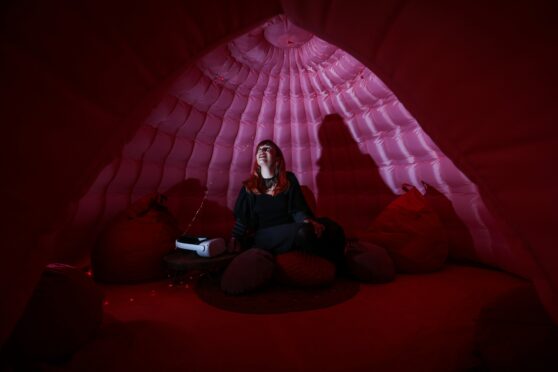It may not have crystals, as the Swarowski sign above the storefront suggests, but the Inter/Her exhibition is a gem of another kind.
Showing as part of the NeoN Digital Arts Festival’s Wired Women celebration until November 13, artist Camille Baker’s Inter/Her exhibition has taken over the old Swarovski unit in Dundee Overgate Shopping Centre with a huge, pink, igloo-like dome.
But where did this weird and wonderful structure come from? And what’s it all about?
‘A culture where you do what you’re told’
Canada native Camille Baker teamed up with talented female artists Maf’j Alverez, Sarah Büttner, Bushra Burge and Kat Austen to create Inter/Her after her battle with ovarian cancer left her fired up to educate women about their bodies.
After two surgeries, University of Creative Arts lecturer Camille has been cancer free for five years now, but her memories of her experiences she had as a patient still astound her.
The problem with cancer is it’s like a mouse in a warehouse. We just bomb the whole thing and hope we get it.”
“I went to one specialist,” shares Camille. “And she encouraged me to have a full hysterectomy. She basically said: ‘The problem with cancer is it’s like a mouse in a warehouse. We just bomb the whole thing and hope we get it.’
“I was like: ‘What?!’
But Camille was most shocked by the lack of agency felt by other female patients she met when going through treatment.
“I saw some women on my ward when I’d have had my second surgery and two of them had had full hysterectomies,” she says. One said she’d had a full hysterectomy for her fibroid. And I asked her, ‘What are you going to do afterwards, treatment-wise?’
“She said: ‘I don’t know. I haven’t had that conversation with my doctor. He just told me to do this, so I did.’
“I just was utterly shocked. I just couldn’t understand why someone wouldn’t want to know why their doctor has done that. But I understand more now – we have a culture where you do what you’re told.”
After her treatment, Camille felt she had to help educate women about their bodies before they were in a situation like hers, where they had to learn about their anatomy in order to advocate for themselves amid the distress of diagnosis.
What do you do in the pink igloo?
Enter Inter/Her. The interactive, immersive exhibition tackles the topic of women’s health by combining virtual reality, wearable tech and storytelling.
Visitors go on a journey inside the female body, entering the pink inflatable “womb” and then using a VR (virtual reality) headset to move around the reproductive system.
Ick-free and family-friendly…”
A specially designed haptic corset provides a sensory element, with the corset buzzing, vibrating or pulsing to indicate where the different issues may be felt as pain points on the body. (All equipment is thoroughly cleaned and disinfected between visitors.)
Ick-free and family-friendly, the piece uses artistically uses flowers, fungi and floating orbs to represent the internal reproductive system in a way that allows visitors to visualise internal growths and conditions that are often made scary by the unknown.
Fibroids, polyps, cysts, tumours and endometrial tissue are all given a spotlight. And testimonies from real women accompany each new health obstacle.
The subject matter can be emotional or uncomfortable for some, so Camille takes time out after each session to talk face-to-face with visitors about their experience in the dome.
And according to Camille, a common theme of these conversations has been a lack of education around women’s reproductive health, with many young women thanking her for educating them about their bodies.
Need for ‘body education’, not just sex ed
But with a wealth of approachable, straightforward information packs available, provided by Macmillan Cancer Support and the Inter/Her team, Camille hopes the experience is inspires women to feel more in charge of their health by feeling more informed about their insides.
“We need to have more education in schools,” she says. “Not just sex education, but body education, especially for young women.
“If women knew more about what’s going on in their bodies, they might be able to take more control.”
But, as she points out, Inter/Her is “not a science experiment or an anatomy lesson”. Instead, the artist explains, it’s a conversation-starter.
“The more women I talked to in this exhibition, the more emboldened I feel. We need to have these conversations.
“And if it’s not going to happen for us, we need to organise to do it ourselves.”
Visit Camille’s website to find out more about her work, or the Wired Women webpage for more information on this year’s NeoN festival theme.
Cancer support resources are available from Macmillan Cancer Support.
